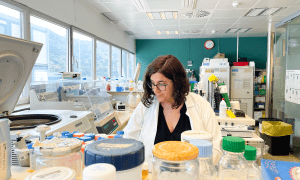The battle between host and donor immunity, crucial in reducing HIV reservoir after stem cell transplant

IrsiCaixa, as coordinator of the international consortium IciStem, has led a pioneering study that highlights which factors trigger the reduction of the HIV reservoir after a stem cell transplant
Currently, stem cell transplant is the only medical procedure that has dramatically reduced the HIV reservoir and even achieved remission or cure in 6 people worldwide. As it is a complex and high-risk intervention that can only be carried out in very specific cases –people who, in addition to living with HIV, suffer from a blood cell cancer– the mechanisms behind this decrease in the reservoir have not been thoroughly studied. Now, a new international study published in the Lancet HIV journal and led by IrsiCaixa –a centre jointly promoted by the "la Caixa" Foundation and the Department of Health of the Government of Catalonia– presents the results of the largest follow-up conducted to date on the evolution of the HIV reservoir after receiving a stem cell transplant. Specifically, the research team has observed that the reservoir of transplanted individuals decreases dramatically and immediately after receiving the graft with new stem cells, regardless of whether the donor had the CCR5Δ32 mutation, known to confer protection against HIV infection. Additionally, and for the first time, it has been demonstrated that specific antibodies for HIV, although they also decrease, do not do so as instantaneously as the reservoir, as their decline extends to a few months after transplantation.
"Thanks to this pioneering study, we have been able to highlight the importance of factors other than the CCR5Δ32 mutation in achieving a significant drop in the HIV reservoir", explains Javier Martínez-Picado, leader of the study, ICREA researcher at IrsiCaixa, and associate professor at UVic-UCC. "In fact, the reduction in the size of the reservoir would be determined, in addition to the chemotherapy received before transplantation, by how the donor's cells manage to establish themselves in the body without being infected. In this battle of immunities, the CCR5Δ32 mutation would be a protective factor in the case of persistence of residual viruses in the body, but not determinative for reducing the reservoir", he adds.
The importance of donor immunity
This work is the first to offer detailed information on the dynamics of the HIV reservoir in a large group of people undergoing a stem cell transplant. "For more than 8 years, we have collected biological samples from the 30 people who belong to the IciStem patient cohort, and this has allowed us to observe how HIV behaves in the blood and tissues of these individuals", explains Maria Salgado, co-author of the study and IGTP researcher at IrsiCaixa. Thanks to having a large international cohort, the scientific team has been able to estimate the half-life of the HIV reservoir after receiving a transplant, and the value obtained is one and a half months.
Indeed, the study provides new information on the mechanisms that contribute to the significant reduction of the HIV reservoir. While cases of HIV remission reported so far suggest that the CCR5Δ32 mutation could play a key role in achieving HIV cure, the results obtained from this study focus on the immunity of donor cells, which is proving to be the main factor related to the reduction of the viral reservoir.
"Of the 30 people who participated in the study, only 10 received cells from donors with the CCR5Δ32 mutation, so we have seen that there are no differences in the reservoir decline between these individuals and those who received the graft from a donor without the mutation", says Salgado. "This leads us to confirm that this decline in the reservoir depends much more on the transplant itself than on the CCR5Δ32 mutation. Thus, the mutation, despite playing a protective role in preventing the viral reservoir from increasing again after transplantation, is not a determining factor in reducing that reservoir", she adds. However, in the face of evidence, the scientific staff suggests that it is of interest to develop therapeutic strategies that mimic the protective barrier conferred by the mutation.
Immediate and prolonged reduction of the reservoir
The findings of the study show that, once the transplant is fully achieved, there is an immediate reduction of the HIV reservoir in peripheral blood. Simultaneously, viral DNA becomes undetectable in various tissues, such as bone marrow, part of the small intestine, lymph nodes, and cerebrospinal fluid. All this, regardless of the CCR5Δ32 mutation. Additionally, the data obtained on the quantity and quality of specific antibodies against HIV demonstrate for the first time that the decline in antibodies occurs later than the reduction of the HIV reservoir. "While we see that the level of antibodies decreases after transplantation, it is possible that it is not a predictor of total virus eradication", explains Cristina Gálvez, co-author of the study and researcher at IrsiCaixa at the time of the study.
The study, therefore, raises the debate about which marker would be the most reliable when analyzing the HIV reservoir after transplantation. While the disappearance of antibodies has traditionally been used as a marker, the lack of immune responses from T cells could be a more reliable indicator, according to this study. This work marks a significant step in understanding HIV persistence after transplantation and highlights the potential of innovative approaches in the search for an HIV cure.